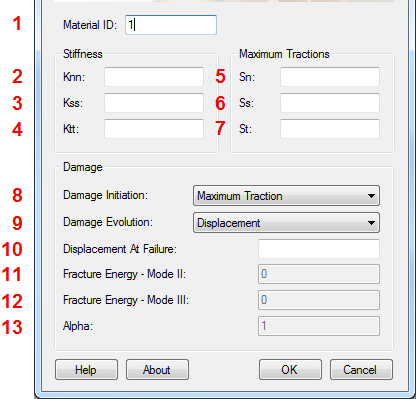Create Cohesive Materials
Use the Create Cohesive Material GUI to create a cohesive material.
Each cohesive material processed by Helius PFA is considered by ANSYS to be a user-defined material. The Create Cohesive Material GUI provides a simple means of creating these cohesive material definitions in the ANSYS input file. It allows you to fully define the cohesive material including damage initiation and damage evolution parameters.
To open the Create Cohesive Material GUI from within ANSYS MAPDL, click the HELIUS button and select Create Cohesive Material. The interface will appear as shown below.

As shown above, there are numerous steps involved in using the Create Cohesive Material GUI to define a cohesive material type for Helius PFA. Each of these steps is discussed below. See Appendix B for a technical discussion of these parameters.
Material ID - Enter the ID of your material.
Normal Stiffness - A number greater than zero which defines the normal stiffness, Knn, of the cohesive material. Knn relates the normal traction in the cohesive material to the strain as
tn = Knnεn
where tn is the normal traction and εn is the strain in the normal direction (local 3-direction).
First Shear Stiffness - A number greater than zero which defines the first shear stiffness, Kss, of the cohesive material. Kss relates the traction in the local 1-direction in the cohesive material to the strain as
ts = Kssεs
where ts is the first shear traction and εs is the strain in the local 1-direction.
Second Shear Stiffness - A number greater than zero which defines the second shear stiffness, Ktt, of the cohesive material. Ktt relates the traction in the local 2-direction in the cohesive material to the strain as
tt = Kttεt
where tt is the second shear traction and εt is the strain in the local 2-direction.
Maximum Normal Traction - A number greater than zero which represents the maximum amount of traction the cohesive material can sustain in the normal direction (local 3-direction) before damage initiates, Sn.
Maximum First Shear Traction - A number greater than zero which represents the maximum amount of traction the cohesive material can sustain in the local 1-direction before damage initiates, Ss.
Maximum Second Shear Traction - A number greater than zero which represents the maximum amount of traction the cohesive material can sustain in the local 2-direction before damage initiates, St.
Damage Initiation Criterion - Allows you to select a maximum traction or quadratic based damage initiation criterion. The maximum traction criterion defines damage initiation as the point when any of the tractions meet or exceed their corresponding maximum traction value. The quadratic based criterion uses a quadratic interaction of the traction to maximum traction ratios to predict damage initiation.
Damage Evolution Method - Allows you to select how damage will evolve after damage initiation. Once damage initiates in a cohesive material the stiffness of the material decreases as material deformation increases. Eventually, the stiffness of the cohesive material will reduce to zero and the material will no longer sustain any load. The three available methods are:
Displacement
Energy
Energy (Mixed Mode, Power Law)
Variable Parameter - The choice of the damage evolution method dictates the input for this field. The inputs for each damage evolution method are:
- Displacement - This value is the displacement at failure which is a number greater than zero that defines the difference between the effective displacement at complete failure and the effective displacement at damage initiation,
 .
. - Energy - This value is the fracture energy which is a number greater than zero that defines the total energy dissipated due to failure, GC. In mathematical terms, this value is the area under the traction - separation curve.
- Energy (Mixed Mode, Power Law) - This value is the normal mode fracture energy which is a number greater than zero that defines the total energy dissipated due to failure under a pure normal mode,
 .
.
- Displacement - This value is the displacement at failure which is a number greater than zero that defines the difference between the effective displacement at complete failure and the effective displacement at damage initiation,
First Shear Mode Fracture Energy - A number greater than zero which defines the total energy dissipated due to failure under a pure first shear mode,
 .
.Second Shear Mode Fracture Energy - A number greater than zero which defines the total energy dissipated due to failure under a second shear normal mode,
 .
.Alpha - The exponent used in the mixed mode power law damage evolution equation, α.